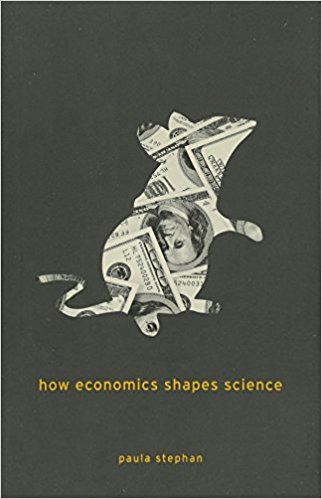Editor’s Note: Given the significant impression that keynote speaker Paula Stephan made at this year’s Society for Scholarly Publishing Annual Meeting, I wasn’t sure if attendees were aware of this pair of Kent Anderson posts from 2012, a review of Stephan’s book on the economics of scientific research and (re-running tomorrow) an interview with Stephan. Although the posts are now more than five years old, the economic conditions described have only accelerated.
I recently finished a very interesting and useful book entitled, “How Economics Shapes Science,” written by the economist Paula Stephan (Professor of Economics, Georgia State University and a member of the National Bureau of Economic Research). Stephan is an economist who accidentally became an expert in science economics, a little vignette that sets a nice tone for the book, which is superb overall — well-written, smartly structured, and well-referenced. In fact, for the serious reader, I’d recommend ordering it in print because the ability to flip back and forth between the nicely designed and very usable notes pages and the main text is vital to enjoying the book.

While the topic is of inherent interest to anyone working in the sciences, Stephan also touches on many points of particular interest to publishers, including why authors publish and related issues.
Stephan’s main point is that while the information emanating from research activities is itself hard to take to market — it is non-rival and non-excludable — the economic units of value to scientists are prestige and priority. These aren’t new ideas at all, but Stephan is able to bring data together to underscore how vital the incentives of prestige and priority are — they determine what happens to scientists, from lab space to letterhead.
There are many interesting themes in the book, from the way university research changed with the 1982 Bayh-Dole Act (which gave universities new control of patents and other IP emanating from federally funded research), to the proliferation of prize-based science, to the growth of the mega-foundations like HHMI and Wellcome, to the sometimes dramatic effects funding decisions can have, both when it grows and when it shrinks.
Perhaps the most interesting story in this story-packed book is the tale of the years 1998-2002, when the NIH budget doubled. This vast influx of funding had many unanticipated and some unproductive outcomes:
- Success rates for R01 grant applications didn’t rise, and in fact fell significantly by 2009
- Universities used the funding to justify a building binge, partly to lure prime faculty and partly to create capacity for the anticipated grants
- Grants grew in size, and absorbed more costs, like graduate student tuitions and other overheads
- The short-term nature of the doubling, combined with the long-term nature of the resulting grant commitments, created a dearth of money in subsequent years, as funding fell yet remained tied to previous commitments
- The NIH took monies away from R01 grant-making during the expansion to pursue other, larger initiatives
- Younger researchers suffered more, as renewing grants did better overall during both the funding boom and the subsequent cuts
- The number of papers resulting from the doubling of NIH funding remained stubbornly unaffected — as one study put it, “Wherever the funds went, they left no clear scientific record.”
This is the kind of rich, data-driven, and nuanced discussion of science and economics readers can expect throughout Stephan’s excellent book.
Stephan addresses how R&D spending is often driven by politics — either geo-politics (the Cold War) or personal politics (biomedical research), and how jobs in the sciences respond accordingly (and how competitive options for smart people have affected job uptake). She also talks about how difficult science and research spending is to measure from an economic efficiency perspective — essentially, because payback on investments can be quite indirect and take decades, choosing between investment options is fraught with the chance for mistakes. And the emerging trend showing that higher-impact science comes from funding entities that evaluate people instead of projects and provides longer-term funding is also covered.
Many of the studies Stephan had to work with are dated, unfortunately, suggesting strongly that we need to do more (and more current) studies of these issues. It’s clear that economics shapes science. This becomes clearest at the end of the book, in a chapter entitled, “Can We Do Better?”. Here, Stephan writes sentences that bristle a bit:
In many ways universities in the United States behave as though they are high-end shopping malls. . . . faculty “pay” for the opportunity of working at the university, receiving no guarantee of income if they fail to bring in a grant. . . . The system that has evolved discourages faculty from pursuing research with uncertain outcomes. . . . The current university research system in the United States also discourages research that could disprove theories.
This book will have a special place on my shelf, as one of a handful of books that demand to be revisited, referenced, and re-read because there is so much clear and important information to be had, and some definite criticisms of the current system policy-makers need to consider.
Discussion
1 Thought on "Revisiting a Book Review: How Economics Shapes Science by Paula Stephan"
Yes, indeed, research spending is driven by politics. Battling post-truth tendencies, the Director of the NIH, albeit ephemerally, recently pondered the notion of a cutoff in maximum funding for “leading” researchers. He seems to have recalled the truths long ago advanced by Erwin Chargaff ‘s “In Praise of Smallness” , that research productivity is not a linear function of grant dollars allocated. Although difficult to precisely quantify, numerical evidence, similar to that which influenced the Director, was made available by David Currie as the “Law of Diminishing Returns” in the Canadian journal University Affairs (Jan 2010; pp. 26-27) and in Nature (2009; 461, 1198). Michael Lauer has recently provided further data.
Sadly the Director soon changed his mind. While many “leading” scientists do great work and can justify every dollar their laboratories receive, anyone who has read Thomas Soderqvist’s biography of Niels Jerne, or the “The Network Collective” by Klaus Eichmann (2008), knows that too often the “Trumps” of science win out over the scientific “Clintons.” Hopes for light at the end of the tunnel continue to dwindling!



